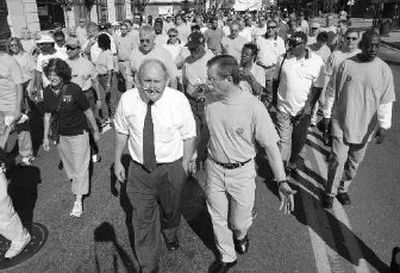Unions face watershed moment

DETROIT – The outlook for organized labor seems to grow worse by the day in this year of turmoil for unions.
Auto supplier Delphi Corp. filed for bankruptcy this week, putting thousands of union jobs at risk. Northwest Airlines Inc., also in bankruptcy, is still flying despite a strike by its mechanics union. And the Teamsters and other unions broke from the AFL-CIO this summer, saying the larger union confederation has lost its effectiveness.
Harley Shaiken, a professor at the University of California in Berkeley who has written extensively on labor issues, said the challenges are intensifying. “You’ve got the pressures of the global economy, fierce competition in deregulated industries like airlines and powerful anti-union employers like Wal-Mart,” he said.
There have been some successes. Boeing Co. machinists got increased pension pay and cash bonuses in a contract approved after a monthlong strike. In Canada, autoworkers prevented the closure of some facilities and got modest wage increases after contentious negotiations with General Motors Corp., Ford Motor Co. and DaimlerChrysler AG.
But by and large, unions are in crisis. David Weil, an associate professor of economics at Boston University, compares it to the birth of the modern labor movement in the 1930s and says unions could emerge from their current troubles looking very different.
Delphi, which employs 30,000 U.S. hourly workers, filed for bankruptcy after the United Auto Workers refused to accept a cut in workers’ average wage rate from $27 an hour to a $10- to $12-an-hour range.
The pressure to cut costs is being accelerated by competition from places like Mexico and China, where laborers will work for less than $5 an hour.
“They want us to drop wages down to what they make, and there is no way,” said Allen Huguely of Dayton, Ohio, who has worked for Delphi for 30 years. “Everybody is upset and afraid of what could happen.”
That’s because Delphi could ask a bankruptcy judge to void its labor contracts if the company and the union fail to agree on wage and benefit cuts by mid-December. And it already has signaled it intends to drastically cut back its operations, leaving thousands out of work.
Northwest, which filed for bankruptcy in September, asked a judge this week to void its labor contracts if it can’t agree to new terms with its unions. Doing so would allow the carrier to impose steep pay cuts.
Bankruptcy has been used as a tool to negotiate before with unions in the steel and airline industries. But Peter Stergios, a labor and employment attorney with the law firm Greenberg Traurig in New York, said companies are getting more comfortable resorting to Chapter 11, which usually results in holders of common stock being wiped out.
The advantages can be compelling. Besides winning the right from bankruptcy judges to cut workers’ pay, it allows companies in many cases to escape the burden of billions of dollars of obligations in underfunded pension plans, which are offloaded to the federal Pension Benefit Guaranty Corp.
“That bodes ill for labor,” Stergios said. “The more that do it and succeed, the less inhibited employers may become. It erodes the relevance of unions and portrays them as barriers to the cure instead of the solution.”
Analysts say GM and Ford, also saddled with expensive labor agreements, have enough money that bankruptcy isn’t imminent. But if they can”t negotiate cheaper labor agreements with the UAW in 2007, it would be a possibility.
Unions also are facing a shift in public sentiment. As union membership declines, fewer people are seeing the impact of unions on their lives. In 2004, 12.5 percent of U.S. workers belonged to unions, down from a high of 20.1 percent in 1983, according to the Bureau of Labor Statistics.
New York was the most unionized state in 2004, at 25.3 percent of its workers; North Carolina was the least unionized, at 2.7 percent.
Stergios said employers are more enlightened than they used to be, so fewer workers see the need for unions. People also may be less sympathetic to unions because they’re worried about their own paychecks, Shaiken said.
“The pain and surprise may come when Delphi wages are cut and it sets a pattern of pressing down on wages to succeed competitively,” Shaiken said. “It reverses the success story of the American economy, which has always been that U.S. firms paid the most.”
Still, predictions of the demise of unions are exaggerated, Shaiken said. While Northwest’s mechanics union is relatively small, the UAW is large and powerful, with 1.1 million members and retirees. GM, Delphi’s one-time parent, and other automakers depend heavily on it for parts and a strike could wreak havoc on the auto industry.
“I suspect they don’t want to strike, but they could be pushed into a corner, and if that’s the case they have considerable leverage,” Shaiken said.